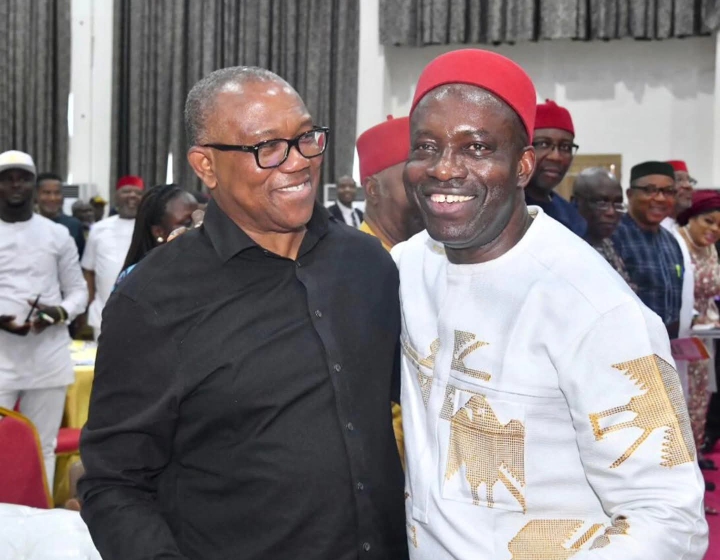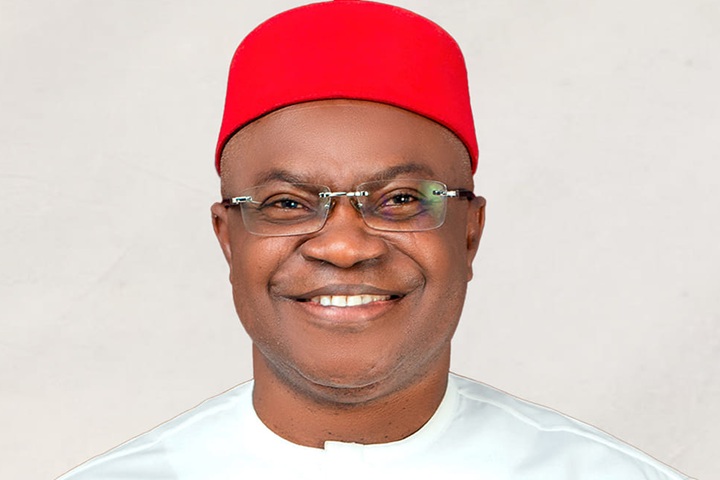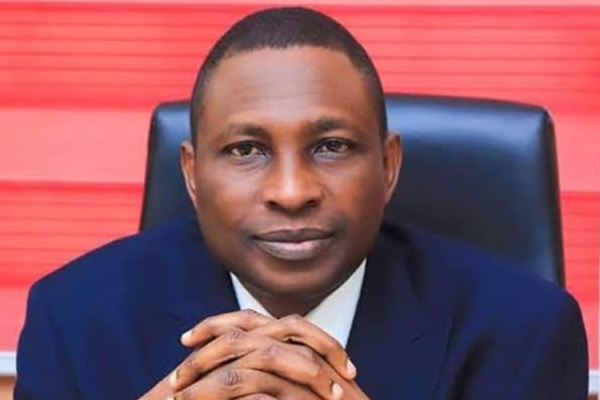News
Thousands Mourn as Tehran Buries Fallen Commanders, Scientists
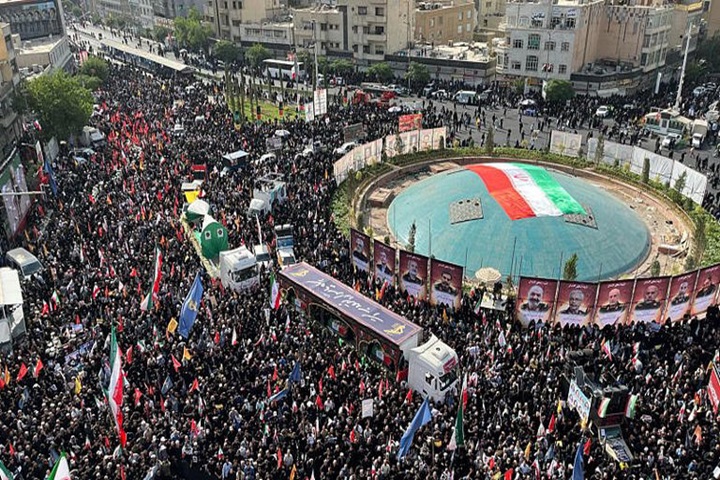
A sea of mourners flooded Tehran ’s streets Saturday for a state funeral honoring IRGC leaders and nuclear scientists killed in clashes with Israel.
Grieving crowds carried flag-draped coffins bearing images of Revolutionary Guard Chief General Hossein Salami and General Amir Ali Hajizadeh, both slain in Israeli airstrikes.
Chants of “Death to Israel” echoed as portraits of the dead lined the procession route.
State media reported 60 casualties, including women and children, though crowd estimates remain unverified.
The strikes, targeting nuclear and military sites, marked Israel’s boldest move yet to cripple Iran’s atomic program.
Tehran insists its nuclear ambitions are peaceful, but Israel calls them an existential threat requiring military action.
Notably absent was Supreme Leader Ayatollah Ali Khamenei, though top officials like Foreign Minister Abbas Araghchi joined the somber event.
The IRGC, born from Iran’s revolution, has grown into a regional power broker, backing allies and managing missile programs.
Its leaders’ deaths leave a void in Tehran’s strategic operations.
The conflict erupted June 13 when Israeli jets bombed Iranian facilities, triggering retaliatory threats.
U.S. involvement escalated tensions further, with American strikes hitting three nuclear sites before a ceasefire took hold Tuesday.
Observers warn the violence could destabilize the region long-term.
As families buried loved ones, analysts debated Iran’s next steps. Will it seek revenge or regroup under new leadership?
The funeral’s scale reflects national resolve, but the losses may force tactical recalibration.
Meanwhile, global powers watch closely, aware that Middle East stability hangs in the balance.
The strikes’ precision stunned experts, exposing vulnerabilities in Iran’s defenses.
For Israel, eliminating top IRGC figures delivers a strategic win, yet risks provoking shadow warfare.
Tehran now faces a crossroads: escalate or consolidate. Either choice will ripple across proxy battlegrounds from Syria to Yemen.
Funeral pyres smolder as dusk falls over Tehran.
The crowd’s fury mirrors official rhetoric, but behind closed doors, calculations begin.
How Iran responds could define the region’s future—and rewrite the rules of this decades-old feud.
News
2027 polls: Etinan Federal Constituency endorses Tinubu, Eno
...as Gov. Eno doles out N361m to business owners, farmers, others

In what turned out to be a climax in a season of appreciation and endorsements, the People of Etinan Federal Constituency have reaffirmed their solidarity to the Government of Pst Umo Eno,PhD, and have pledged their resolve to support his re-election, and the re-election of President Bola Ahmed Tinubu for a second term in office.
This is as the Akwa Ibom State Governor, Pastor Umo Eno has doled out N361,450,000 to 844 persons from Etinan Federal Constituency.
The donation comes in the form of farmers grants, traders grant, equipment support, MSMEs, cars and mini buses beneficiaries.
At what was tagged a grand finale in the series of Town Square meetings between the Governor and his people, held at the Nsit Ubium Council Headquarters ground in Ikot Edibon, the people unanimously voted in support of the continuation of the Governor in office.
The Governor had thanked the people for the massive turnout saying “it is organic, spontaneous and electrifying.”
He said having received the needs documents from all the federal constituencies, he was going to select the very critical ones for inclusion in the 2026 budget, noting that some could still be captured in the remaining part of the subsisting budget.
The Governor said the recent Impact Assessment Summit organized by his government, afforded everyone opportunity of seeing that every local government in the State has been positively affected by his administration, but added that where gaps were noticed, corrections would be effected.
On his policy of establishing Youth Friendly Centers in all the local government areas, the Governor urged local council chairmen to each, avail him of 1000sq meter of land for the project, and also harped on the essence of encouraging youths in computer training.
Following the premises laid by speakers at the event, a voice vote was moved by the Nsit Ubium State Constituency lawmaker, Otobong Bob and seconded by Hon Eric Akpan of Nsit Ibom State Constituency with the people affirming their decision to support the All Progressives Congress and its candidates Governor Eno and President Tinubu.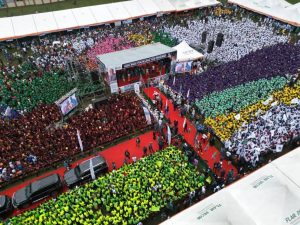 Speaking, stakeholders of the federal constituency, through their Political Leader, Senator Effiong Bob, held that Governor Eno’s performance had endeared him to the people of the entire State, insisting that, “if you were not a good governor they would not have accepted you”.
Speaking, stakeholders of the federal constituency, through their Political Leader, Senator Effiong Bob, held that Governor Eno’s performance had endeared him to the people of the entire State, insisting that, “if you were not a good governor they would not have accepted you”.
“We are not here to speak about what are you doing, or what you have not done, or what you are about to do, because we know that you have done your best within these two years.
Sen Bob who was confirming the position of the earlier speakers at the event, Chief Sunny Jackson Udo, Mr Umana Umana and Hen Paul Isang,Rtd, said, “You have 8 yrs mandate, so your mandate will be judged at the end of 8 yrs, but for the two years, you have done so much for our people as had been said in the programme”, he said wooing for support for President Tinubu, Senate President Godswill Akpabio and the Governor.
On his part, the Oku Ibom Ibibio and President-General of the Supreme Council of Traditional Rulers, His Eminence, Ntenyin Solomon Etuk, acknowledged that God has used the Governor to accomplish much for the State.
He said the huge crowd was a true reflection of the love and confidence of his people in him.
“As royal fathers, our role is to guide and advise, and in that spirit, I thank you sincerely for all you are doing for the sons and daughters of Akwa Ibom State. We are confident that you will not let your people down.
“We are proud to identify with you, to support you, and to pray for your continued success. Already, you have been named the Best Performing Governor in Nigeria, and we encourage you to keep up the good work so that you will continue to win even greater honors”, the monarch added.
Also speaking, the Chairman of Nsit Ubium Local Government Area, Alfred Charles, on behalf of the three chairmen in the constituency, hailed the Governor as “the pride of Etinan Federal Constituency”, assuring that the constituency would stand solidly behind him all the way.
This was corroborated by the Attorney General and Commissioner for Justice, Uko Udom, SAN, who spoke on behalf of members of the State Executive Council from the constituency.
Earlier, the Secretary to the State Government, Mr Enobong Uwah, described the Governor as a compassionate and inclusive leader, as well as the best performing Governor in Nigeria, who in just two years, has earned the love of his people and a doctoral degree in learning.
He thanked the Nsit Ubium people for supporting their son, assuring everyone that, “you have a Governor who is not just performing, but excelling”.
Highpoints of the occasion was the symbolic presentation of cheques to some of the beneficiaries by the State Chairman of the APC, Obong Stephen Ntokekpo.
News
Tinubu govt seeks $238m loan from Japan

The Federal Government is currently in discussions with the Japan International Cooperation Agency (JICA) to secure a $238 million loan aimed at transforming Nigeria’s electricity transmission network and boosting power supply across the nation.
These discussions took center stage during the Ninth Tokyo International Conference on African Development (TICAD 9), held in Yokohama, Japan, where President Bola Tinubu led Nigerian delegation, including Minister of Power Adebayo Adelabu and other senior officials.
As part of the event, the Nigerian delegation engaged with top Japanese energy giants like Toshiba, Hitachi, Japan’s Transmission & Distribution Corporation, and Energy Exchange Corporation.
The discussions focused on major investments in transmission infrastructure, improving grid efficiency, and reducing system losses.
This proposed facility is anchored on Nigeria’s recent Federal Executive Council (FEC) approval of ₦19 billion in counterpart funding, which is expected to unlock JICA’s support.
The loan will fund the construction of nearly 103 kilometers of 330kV double-circuit transmission lines and 105 kilometers of 132kV double-circuit lines, along with multiple substations and line bay extensions across the country.
These upgrades aim to enhance the reliability and efficiency of Nigeria’s power grid while addressing critical system losses.
Minister Adebayo Adelabu also shared that Nigeria is pursuing a separate $190 million renewable energy loan with JICA to scale solar mini-grids and other off-grid solutions in underserved communities.
This initiative complements the $750 million World Bank-backed Distributed Access through Renewable Energy Scale-up (DARES) program under the Mission 300 Compact, which seeks to provide clean and reliable electricity to over 17 million Nigerians.
Additionally, three JICA-funded substations—located in Apo (FCT), Keffi (Nasarawa State), and Apapa (Lagos State)—are nearing commissioning. Built with a $32 million JICA grant, these facilities are set to improve power delivery to homes, businesses, and critical infrastructure, such as Lagos Port.
JICA’s contributions extend beyond infrastructure. The organization has equipped the National Power Training Institute of Nigeria (NAPTIN) in Abuja with cutting-edge training tools to enhance the technical expertise of local engineers.
Minister Adelabu highlighted the importance of this facility in fostering long-term sustainability through capacity development.
While speaking at a panel session titled “HICKARE Africa: Harnessing Innovation, Co-creation, and Knowledge for Accessible and Resilient Energy for Africa”, Adelabu pointed out that only about 60 percent of Nigeria’s 200 million citizens currently have access to electricity, much of which is unreliable.
He emphasized the government’s dual approach of expanding the national grid in urban areas while accelerating solar and off-grid solutions in rural communities.
Despite challenges such as limited access to affordable capital, high costs for rural electrification, and the under-utilization of productive-use equipment, Adelabu reaffirmed the government’s commitment to overcoming these obstacles through supportive policies, private-sector partnerships, and local manufacturing of renewable energy components.
He praised JICA and the Japanese government as “reliable partners in advancing Nigeria’s energy transition” and ensuring access to sustainable, affordable electricity.
President Tinubu echoed this sentiment, underscoring Nigeria’s focus on achieving concrete results from international partnerships.
“Nigeria is deliberately shifting from planning to implementation, from agreements to delivery, and from promises to measurable results”, he stated, emphasizing that the country’s participation at TICAD 9 was about creating real impact, not symbolic gestures.
News
Suspected ritualists kill pregnant woman

A horrifying tragedy has shaken the Temidire community in Egbejila, Ilorin, Kwara State, as a pregnant woman was gruesomely murdered in what residents fear may be a ritual killing.
The victim, whose identity remains unknown, was killed on Thursday, August 21, 2025, in a chilling incident that has left locals reeling.
Eyewitness accounts revealed disturbing details about the circumstances surrounding her death.
The woman, reportedly married to a trader dealing in agricultural chemicals and equipment in Kwara North, was home alone on Wednesday night.
Residents alleged that she had been expecting a visitor that evening and was seen purchasing bottles of beer and plates of pepper soup before heading indoors. By dawn, suspicion was raised when a neighbor confronted a man, believed to be her husband’s younger brother, leaving the house with a black nylon bag that was dripping liquid.
Upon closer inspection, the trail was discovered to be blood, prompting alarm and drawing the community together.
The discovery that followed was gruesome. Body parts suspected to belong to the victim—including an arm, a leg, and entrails—were found scattered in nearby bushes, but her head was missing.
The shocking nature of the crime has heightened fears of ritual killings and deepened ethnic tensions in the area, as whispers of dark motives and networks of ritualists spread among residents.
This incident has drawn chilling parallels to a previous case in Ilorin involving Abdulrahaman Bello, a self-styled cleric who murdered Yetunde Lawal, a final-year student of Kwara College of Education, for body parts earlier this year.
The similarities have only fueled panic in the community, which is already grappling with fears of insecurity.
Police sources have confirmed that the case has been transferred from the Budo Nuhu Divisional Headquarters along Airport Road to the State Criminal Investigation Department (CID) in Ilorin for a thorough investigation.
However, official updates from the Kwara State Police Command remain pending as efforts to reach them have been unsuccessful.
The community is now left in a state of unease, demanding answers and justice for the victim while grappling with the specter of ritual killings that seem to be haunting Kwara State.
Africa
JUST IN: Burkina Faso Bans Bill Gates-Backed GMO Malaria Project

Burkina Faso’s military government has halted a malaria eradication project backed by billionaire philanthropist Bill Gates and his foundation.
The project, run by the research consortium Target Malaria, focused on releasing genetically modified mosquitoes into the environment to help eradicate malaria.
On Friday, authorities ordered Target Malaria to immediately suspend all operations in the West African nation.
The move marks yet another clash between the government and international non-governmental organizations, many of which have faced intense restrictions under military rule.
The decision sparked heated reactions from civil society groups. Opponents of the project argue that Burkina Faso should focus on safer and more traditional solutions rather than experimenting with controversial genetic technologies.
A spokesperson for a coalition campaigning against the project stated that citizens “deserve protection through proven health measures, not risky experiments.”
Target Malaria, however, defended its work.
The group insisted that since 2012, it has complied with Burkina Faso’s national laws and worked closely with local authorities.
It expressed readiness to cooperate further with the government despite the sudden suspension.
The project has faced criticism not only within Burkina Faso but also internationally.
It became the target of online disinformation campaigns that claimed the genetically modified mosquitoes posed unforeseen dangers to the ecosystem.
While the first release of such mosquitoes took place in 2019, the long-term effects remain under global scientific debate.
Burkina Faso, one of the ten countries most affected by malaria, recorded more than eight million cases in 2024 alone.
The disease remains one of the leading causes of death in the country, particularly among children under five.
Supporters of the Target Malaria initiative argue that innovation is crucial to ending this deadly cycle, but critics fear it could introduce new risks.
This ban comes amid wider tensions between the military rulers and international organizations.
Since seizing power nearly three years ago, Captain Ibrahim Traoré’s administration has increasingly tightened control over foreign-funded NGOs.
In recent months, the government revoked the licenses of at least 21 groups, accusing some of pushing foreign agendas and destabilizing national sovereignty.
Analysts see the latest crackdown as part of a broader trend. Burkina Faso’s rulers are distancing the country from Western-backed projects while strengthening ties with alternative global partners.
However, the sudden halt to malaria research may come at a cost, as the country continues to battle one of the world’s deadliest diseases.
For now, the future of genetically modified mosquito projects in Burkina Faso remains uncertain.
The debate highlights the sharp divide between innovation and caution, science and politics, as the country balances urgent health needs with national sovereignty concerns
News
Paul Chukwuma joins peaceful march against Udogachi, SASA operatives in Anambra

The candidate of the Young Progressive Party (YPP) in the November Governorship election in Anambra State, Sir Paul Chukwuma, on Friday joined a peaceful march against the intimidation and abuse meted out to Ndi Anambra by operatives of Udogachi and SASA through misuse of governmental authority.
Udogachi, a security outfit created by the Soludo-led Government and the SASA, an anti-touting agency otherwise known as Ndi Akodo, which is notorious for using pestles on citizens, have come under intense scrutiny owing to the numerous clips of their abuses against the people.
In the past week, operatives of Udogachi have come under serious criticism for manhandling a young girl who is a serving youth corps member in Oba, Idemili South LGA of Anambra State.
During the peaceful march against the brutality of Udogachi and SASA, which was organized by Make Anambra Great Again, the YPP Governorship candidate regretted that the governor of Anambra State, Professor Charles Chukwuma Soludo, would allow agencies of the State established to serve the people to become instruments of operation against the same people.
“Anambra is not in a good place today. It affects all of us. We are determined to fix our state,” Paul Chukwuma said while addressing a large crowd at Eke Awka market.
The peaceful march, which commenced from Aroma Junction in Awka, terminated at the Anambra State Police Headquarters in Amawbia, where the group was received by the Deputy Commissioner of Police in charge of Operations, DCP Ibrahim Ezekiel.
At the Anambra State Police Command’s office, Sir Paul Chukwuma addressed the DCP and listed some of the reasons for the peaceful march, which include the abuse meted out to innocent citizens by Udogachi and SASA.
He also called on the police to rise up to their responsibilities, while assuring them of support from Ndi Anambra.
“The responsibility placed on the government in terms of protection of lives and properties is well spelt out in the constitution. In Anambra today, we are experiencing what is a negation of the position of the law. We know the agencies of government that are saddled with the responsibility of ensuring law and order in our state. Anambra State is still part of Nigeria as a sub-national entity. We are experiencing something that has never happened in the history of Anambra State…with what is happening today, we are beginning to wonder if the Nigerian Police Force has abdicated their responsibility and duty to Ndi Anambra. Today, we have experienced a litany of what we call an aberration to the protocol of such organization and agency (Udogachi and SASA). A lot of heinous crimes are being perpetrated in Anambra State by the so-called security outfit Udogachi. We don’t have anything against establishing such an outfit. But we are of the opinion that such outfits, when established, must abide by the rule of law,” Chukwuma said.
Reacting, DCP Ibrahim Ezekiel, who stood in for the Commissioner of Police, assured Paul Chukwuma and the group that the issues raised would be addressed by working with all stakeholders.
Speaking on behalf of the group, Nkem Mbonu, the group’s coordinator, said that the group had articulated three clear demands from their engagements with the people of Anambra State.
The demands include: an investigation into cases of missing persons in Anambra State. Secondly, an investigation into the alleged secret cells of Udogachi in Awka and Onitsha. Finally, the assumption of full security of the state by the police, as well as the disbandment of SASA.
The walk, which covered about seven kilometers, was well received by thousands of Anambra residents, who expressed their disapproval of the modus operandi of Udogachi and SASA operatives.
-

 Celebrity/Entertainment2 days ago
Celebrity/Entertainment2 days agoHow Nigerian TikToker Geh Geh Made ₦45 Million in One Night
-
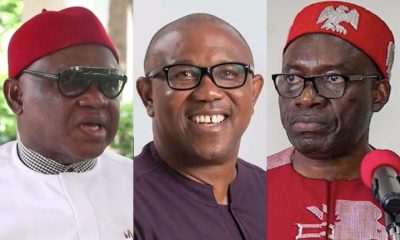
 Featured5 days ago
Featured5 days agoYour Attacks on Peter Obi Are Petty, Stop It! Chekwas Rebukes Soludo
-

 News4 days ago
News4 days agoTension in Anambra community as senior police officer shoots kinsman dead
Colleagues, others try cover-up; victim's family fights back
-

 News6 days ago
News6 days agoNigerian visa applicants must provide 5-yr social media history — US embassy
-

 News4 days ago
News4 days agoTerrorist Organisation: APC, PDP Members in US, UK, France Risk Deportation
-

 Analysis7 days ago
Analysis7 days agoSystemic Sabotage: How APC, INEC Colluded To Undermine Amamgbo’s Senatorial Bid
By Arthur Ezechukwu
-

 Celebrity/Entertainment5 days ago
Celebrity/Entertainment5 days agoWhy single mothers can’t raise boys into proper men — Jim Iyke
-

 News3 days ago
News3 days agoVandal electrocuted while vandalizing Aba power infrastructure
-

 News2 days ago
News2 days agoPeter Obi’s Son Breaks Silence Over His Viral Photos Nigerians Are Talking About
-

 News2 days ago
News2 days ago15% of Nigerian girls aged 15–19 are mothers or pregnant — FG




